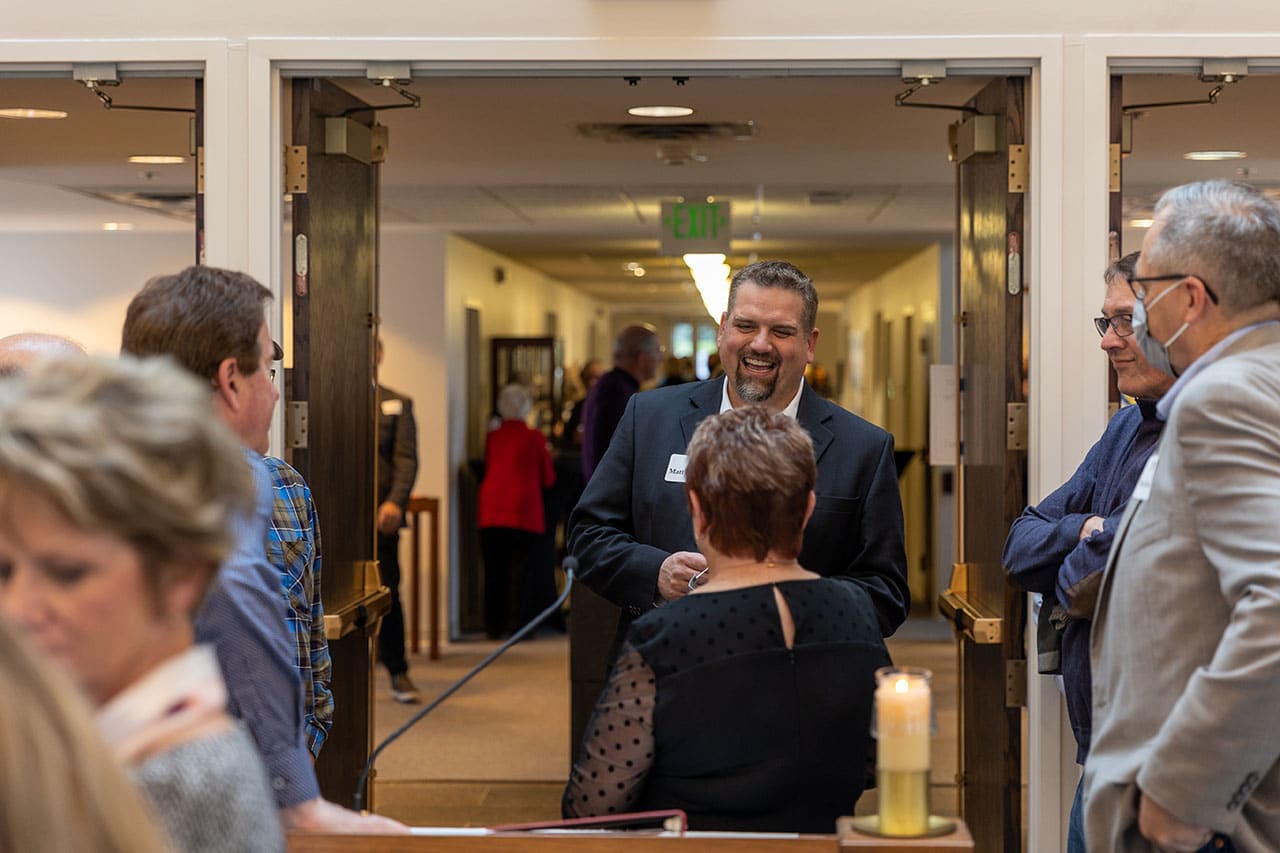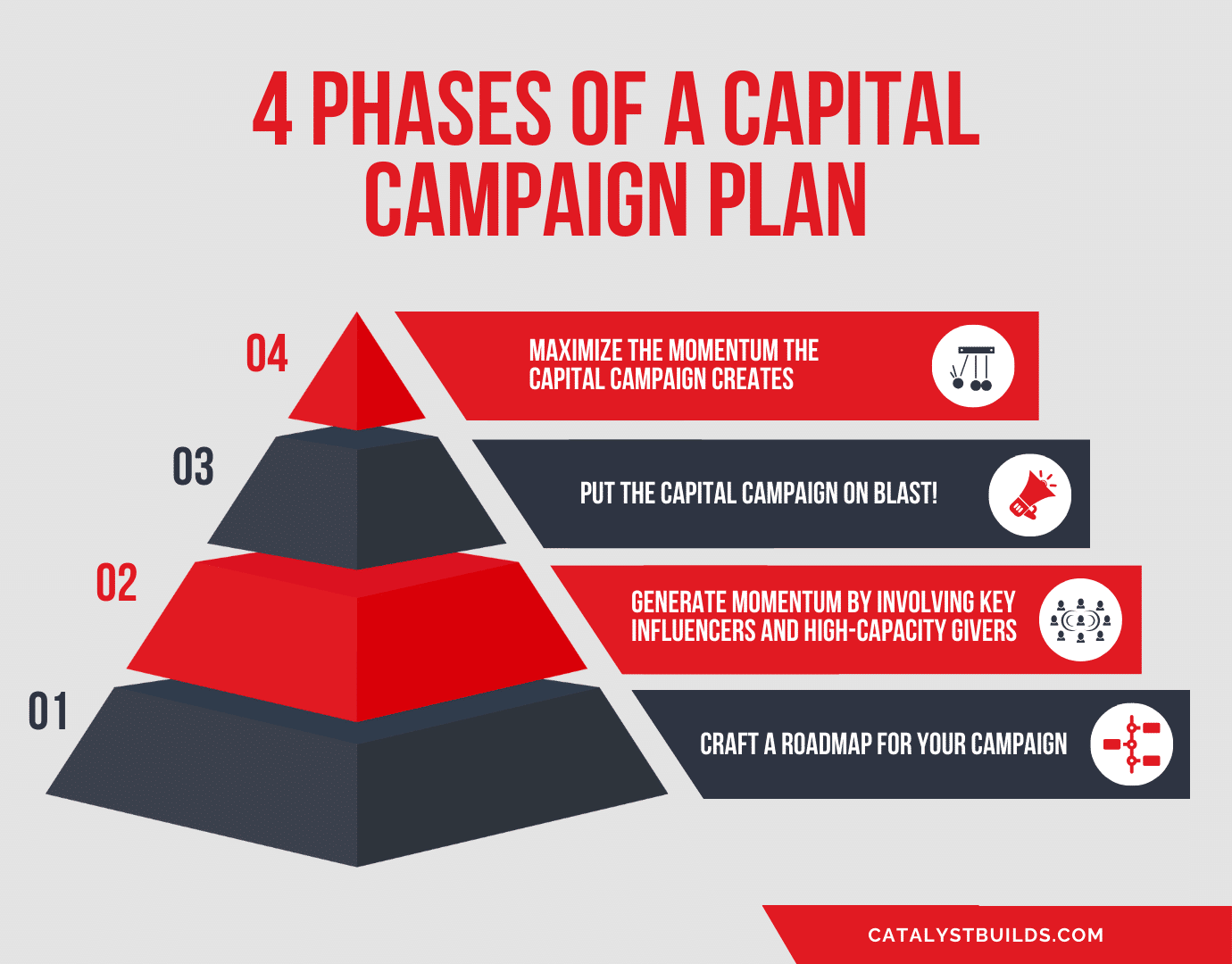The stakes are high with a capital campaign. You put your heart on the line, asking people to follow and sacrificially commit to the vision for the future.
This is no small ask. If people get on board, they invest. Financially. Emotionally. Spiritually. And more.
When done well, a capital campaign can bolster people’s faith, enhance their generosity, and establish a brighter future for the church.
If a capital campaign is not done well, you may fail to achieve your goals, and people can feel let down, or misled by the leaders they trust.
How can you lead a successful capital campaign?
Every successful capital campaign has practical, tried-and-true steps you can take to see your God-inspired vision become reality.
The stakes are high. This is a defining moment in the life of your church and in the journey of faith for your congregation.
We can help you succeed.
Your Guide to Running a Successful Capital Campaign
As our company name implies, construction is our sweet spot. Since 2004, we’ve guided over 100 churches to maximize their impact through construction projects.
New building construction. Additions. Renovations. We’ve done it all.
As a former executive pastor, I want to see you steward the resources God has entrusted you – and take courageous, strategic, wise steps of faith that will empower you to achieve God-sized goals.
This includes leading a successful capital campaign.
4 Phases of a Successful Capital Campaign
While there is room for flexibility and creativity, our experience demonstrates that it’s vital for capital campaigns to follow four phases.
Let’s dig into the details of each phase.
1: Craft a Roadmap for Your Campaign
This phase of a capital campaign isn’t romantic. It can be exciting, but it involves much detail-oriented, back-end work. During the planning phase of your capital campaign, you prepare to generate awareness, create buy-in, and build momentum.
Your first step is determining what communication channels your capital campaign leadership teams will utilize. If you do not have a strategic communication plan, you must establish one BEFORE you begin your capital campaign.
Most likely, the leaders you have involved at this point may prefer particular platforms for communication. Some may lean toward email, others texting, or your church may have its centralized communication system. Regardless of your chosen platform, having everyone communicate in one central place is essential. Otherwise, messages will be missed, some efforts will be duplicated, and momentum will diminish.
Once you have established your communication channels, you can implement the foundational steps of your capital campaign.
Consider the following:
- Establish a timeline for each phase
- Create a style guide that communicates a consistent image with colors, fonts
- Create a logo
- Plan for your printed material like letters, pledge cards, and one-pagers, campaign brochures, or weekly participation booklets. Posters and visuals used from the front during service should also be included.
- Schedule strategic events for communication rollout to different groups and demographics. For prayer and celebration
While materials are being created and schedules are being established, put the prep work into other forms of communication. Ideas include:
- A robust video strategy
- A primary video that emotionally connects people to the campaign
- Story videos for sharing during corporate gatherings through the different phases
- Videos for sharing on social media
- Plan early for your teaching series. If you follow a liturgical calendar, you should plan for an alternative way to consistently communicate the vision for the project.
- A web and social media strategy
With a solid planning phase, you will have the resources to engage fully in the rest of the capital campaign.
2: Generate Momentum by Involving Key Influencers and High-Capacity Givers
We call this the quiet phase. Before going public, you must involve your significant influencers. These people can move the needle and create momentum for the rest of the church. It requires group meetings, events, one-on-one follow-up, and much communication.
Depending on the size of your church, you may want to allow yourself three to six months to execute this phase.
The following groups are the focus during the quiet phase and should have their own event in the communication roll-out.
- Staff and key leadership: elders, leadership board, executive team, etc.
- Influencers: At high capacity financially or of relational influence
- Volunteers and volunteer leaders
Organize an event Geared to the entire staff and Key Leaders
The first event must be catered toward your staff as well as key leaders. They should be informed and aware of the details.
This event aims to ensure everyone is on the same page. This is a chance for them to ask questions and raise any concerns you may not be aware of. However, they need to know your expectations and that everyone is united.
Of course, you don’t want to bulldoze or bully anyone. But you are leading them. So, structure this event to maximize motivation and information.
The goal is to equip and empower your staff to be ambassadors of the vision that will shape the next season of your church.
Plan a Separate Event for Your Key Influencers
Titles only carry so much weight. There are people who move the needle in your church, either through their influence or their generosity.
Both segments of people should be invited to your second event. Share the vision, invite them to join, and be a difference maker for the capital campaign. Provide printed materials so they can have clear, consistent, and specific details to reference as they consider how to be involved.
After the event, you should follow up with each potential influencer one-on-one. This will allow them to share their thoughts and ask questions; at this one-on-one meeting, you will challenge them to invite God into the process as they work to determine their gift. This is when you may challenge those with the financial capacity to consider being a lead gift or maybe THE lead gift.
Keep the Momentum Going – Plan an Event for Your Volunteers
This should be a high-energy, fun, inspiring night. It’s the “big reveal.”
This is your opportunity to share the vision with all who are meaningfully involved in your church.
Your communication should be clear and consistent. Hand out the printed materials to reinforce the message and provide volunteers with detailed information on how they can contribute.
Don’t overlook the opportunity to empower the volunteer base to serve as ambassadors for the capital campaign.
In many ways, they may have the most influential voice.
Why’s that?
Everyone knows they are involved because they want to be – not because of a paycheck or a position. That carries weight in the minds of those who hear them and sets you up for success in the third phase.
3: Put the Capital Campaign on Blast!
This is referred to as the public phase. It’s time to let the cat out of the bag intentionally. You’ll want to budget four to seven weeks for this phase, depending on the size of your congregation.
By this point, 70% of your congregation should be aware of the capital campaign’s purpose. This step should build momentum, spread the vision, and deepen discipleship among the congregation.
We’ve found the following components of communication to be most helpful.
- Make all printed material publicly available, introduce the vision from the front, and begin a 4-5 week spiritual journey for your church. This time should be focused on discipleship for your church, not solely on raising money for a project.
- Strategically teach on or share about the purpose of the capital campaign. This should be how it will cultivate greater spiritual vitality for your church – beyond the project’s completion.
- Challenge the congregation to consider what they can give/pledge
- Collect pledges in writing
- Recap capital campaign vision. Remind the congregation to affirm their commitment
- Celebration time! Collect and communicate all pledges and celebrate how God is moving in your church and the impact you can make.
Once these three phases are completed, it’s time to put the vision to work!
4: Maximize the Momentum the Capital Campaign Creates
In phase four, all your work is put into motion. The planning, funding, and prayer start to come to fruition. This is the fulfillment of a capital campaign.
The duration of a capital campaign’s fulfillment phase depends on the campaign’s length. We recommend a campaign lasting no longer than three years.
One to two years seems to be ideal.
Regardless of the length, endurance is required! Most leaders are exhausted by this point. But closing out the capital campaign is a high-stakes proposition with long-term ramifications.
If not done well, momentum will be thwarted, and the leadership will lose credibility. Further, the next capital campaign will start from a position of skepticism instead of hope.
How do capital campaigns fizzle out? Leaders don’t communicate final, actual numbers. Or project updates or completion. Gratitude isn’t expressed. And more.
But you can lead your people better. Here’s how.
Communicate the Wins
Keep the vision in front of the people and maintain positive momentum. From groundbreakings to structural completion – there is much to celebrate on this journey. Like these examples:
- First-time givers
- New members
- Percentage of people involved in the project
- Testimonies of people stepping out in faith and how God provided
Be Transparent About Running into Roadblocks
Don’t be afraid. The truth is a great ally. Most people understand that major construction projects run into obstacles. Transparent communication – especially of disappointing news – increases trust and often enhances support.
Keep Communicating
You may know the state of the project. But that doesn’t mean everyone else does. People contributing to the capital campaign should be aware of the progress.
Let people know their investment is being stewarded and the finish line is still in sight.
Ask People to ‘Recommit’ to the Vision
When you prioritize communication during the fulfillment phase of a capital campaign, you will position yourself to ask people to “recommit” to the vision. I usually recommend taking this step around the one-year mark.
During the course of a year, some may need to scale back on contributing to their pledge. Also, new people may have joined and be interested in contributing to the capital campaign’s purpose.
Asking people to commit or recommit at the one-year mark often proves fruitful. It honors their involvement while maintaining the momentum needed to get the project to the finish line.
This can be entirely positive. Remind people of the grace they have to jump back in if they need to take a step back. No shame.
Make people aware of the opportunity to increase their generosity if they have experienced unexpected material blessings after they began contributing to their pledge. The opportunities to deepen discipleship and generate generosity are ripe in this season!
Capital Campaigns for Churches Can be Successful!
The stakes are high when undertaking a capital campaign. This isn’t the time to go it alone. You need a guide with a track record you can trust.
You’re not alone. We can help.
From a project’s conception to completion, we would be honored to help you every step of the way. The sooner you reach out, the more access you’ll have to our extensive network of contractors and decades of experience.
Whether you’re processing beginning a capital campaign or looking for experts to help you get to the finish line of a church construction project, we have the expertise you need to maximize your impact.
Ready to get started? Reach out today!







